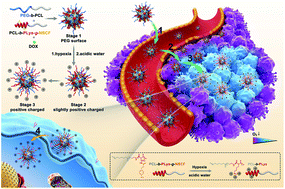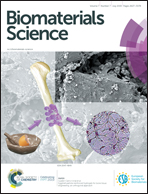Nanocarriers responsive to a hypoxia gradient facilitate enhanced tumor penetration and improved anti-tumor efficacy†
Abstract
Because of their abnormal vasculature and the dense tumor extra-cellular matrix, solid tumors prevent the deep and uniform penetration of nanocarriers. Numerous studies have shown that nanocarriers with a positively charged surface exhibit enhanced tumor penetration. Therefore, a hypoxia responsive nanocarrier [responsive micelles (RMs)] was developed, which can gradually increase the positive surface charge by responding to hypoxia gradients, and eventually achieve deep penetration in tumors. The nanocarrier was composed of a poly(caprolactone) core and a mixed shell of poly(ethylene glycol) (PEG) and 4-nitrobenzyl chloroformate (NBCF)-modified polylysine (PLL). During the blood circulation, the NBCF-modified PLL was shielded by the PEG, which gave it the ability to inhibit its rapid removal by the immune system. After reaching the tumor, the hypoxia microenvironment triggered partial NBCF degradation that recovered the amine groups of PLL, leading to a remarkable change in the surface to a positively charged one that enabled the penetration of the nanocarrier into the tumor. As the nanocarrier penetrated into the interior of the tumor, the decrease in oxygen concentration led to the further degradation of the NBCF-modified PLL, resulting in the increase of the positive surface charge which further facilitated the deep penetration. The subsequent in vitro and in vivo experiments certified that RM/doxorubicin had a better penetration ability and improved inhibition efficacy on tumor tissues, which demonstrated its potential application in cancer therapy.



 Please wait while we load your content...
Please wait while we load your content...